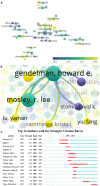Bibliometric analysis of global research trends on regulatory T cells in neurological diseases
- PMID: 37900596
- PMCID: PMC10603183
- DOI: 10.3389/fneur.2023.1284501
Bibliometric analysis of global research trends on regulatory T cells in neurological diseases
Abstract
This bibliometric study aimed to summarize and visualize the current research status, emerging trends, and research hotspots of regulatory T (Treg) cells in neurological diseases. Relevant documents were retrieved from the Web of Science Core Collection. Tableau Public, VOSviewer, and CiteSpace software were used to perform bibliometric analysis and network visualization. A total of 2,739 documents were included, and research on Treg cells in neurological diseases is still in a prolific period. The documents included in the research were sourced from 85 countries/regions, with the majority of them originating from the United States, and 2,811 organizations, with a significant proportion of them coming from Harvard Medical School. Howard E Gendelman was the most prolific author in this research area. Considering the number of documents and citations, impact factors, and JCR partitions, Frontiers in Immunology was the most popular journal in this research area. Keywords "multiple sclerosis," "inflammation," "regulatory T cells," "neuroinflammation," "autoimmunity," "cytokines," and "immunomodulation" were identified as high-frequency keywords. Additionally, "gut microbiota" has recently emerged as a new topic of interest. The study of Treg cells in neurological diseases continues to be a hot topic. Immunomodulation, gut microbiota, and cytokines represent the current research hotspots and frontiers in this field. Treg cell-based immunomodulatory approaches have shown immense potential in the treatment of neurological diseases. Modifying gut microbiota or regulating cytokines to boost the numbers and functions of Treg cells represents a promising therapeutic strategy for neurological diseases.
Keywords: bibliometric analysis; cytokines; gut microbiota; immunomodulation; neurological diseases; regulatory T cells.
Copyright © 2023 Gao, Li, Li, Long, Pan, Wang, Yang and Zhang.
Conflict of interest statement
The authors declare that the research was conducted in the absence of any commercial or financial relationships that could be construed as a potential conflict of interest.
Figures







Similar articles
-
Emerging trends and hotspots in intestinal microbiota research in sepsis: bibliometric analysis.Front Med (Lausanne). 2024 Nov 13;11:1510463. doi: 10.3389/fmed.2024.1510463. eCollection 2024. Front Med (Lausanne). 2024. PMID: 39606629 Free PMC article.
-
Global research trends between gut microbiota and lung cancer from 2011 to 2022: A bibliometric and visualization analysis.Front Oncol. 2023 Feb 23;13:1137576. doi: 10.3389/fonc.2023.1137576. eCollection 2023. Front Oncol. 2023. PMID: 36910658 Free PMC article.
-
The interaction between microbiota and immune in intestinal inflammatory diseases: Global research status and trends.Front Cell Infect Microbiol. 2023 Feb 7;13:1128249. doi: 10.3389/fcimb.2023.1128249. eCollection 2023. Front Cell Infect Microbiol. 2023. PMID: 36824689 Free PMC article.
-
Gut microbiota and eye diseases: a bibliometric study and visualization analysis.Front Cell Infect Microbiol. 2023 Aug 9;13:1225859. doi: 10.3389/fcimb.2023.1225859. eCollection 2023. Front Cell Infect Microbiol. 2023. PMID: 37621873 Free PMC article.
-
Research trends in the field of the gut-brain interaction: Functional dyspepsia in the spotlight - An integrated bibliometric and science mapping approach.Front Neurosci. 2023 Mar 8;17:1109510. doi: 10.3389/fnins.2023.1109510. eCollection 2023. Front Neurosci. 2023. PMID: 36968499 Free PMC article. Review.
Cited by
-
Insight into the research frontier of hypoxia in skin health and diseases: a bibliometric analysis.Ann Med Surg (Lond). 2025 May 29;87(8):4949-4962. doi: 10.1097/MS9.0000000000003303. eCollection 2025 Aug. Ann Med Surg (Lond). 2025. PMID: 40787562 Free PMC article. Review.
References
Publication types
LinkOut - more resources
Full Text Sources

